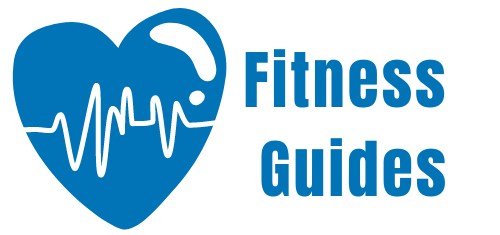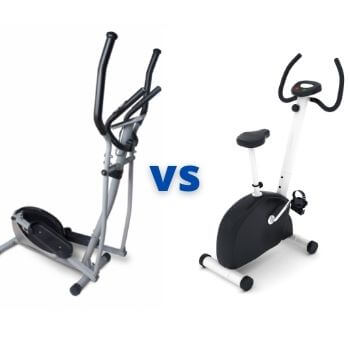The main difference between a cross trainer and an exercise bike is that cross trainers burn more calories by working out your entire body while exercise bikes mostly work your legs only.
They are both practical indoor fitness equipment. They can improve your health, looks, and mindset if you’re using them diligently.
But it’s essential to analyse their features comparatively before making your choice.
Read this short guide below to determine how a cross trainer vs exercise bike can serve your needs best. To this end, we’ll take you through all the science and provide helpful tips on choosing the right piece of equipment.
Keep reading below!
Table of Contents
Cross Trainer Vs Bike Similarities
Let’s look at what both a cross trainer and an exercise bike can do for you:
Improved Heart Health
Both machines help improve cardiovascular fitness and, consequently, your heart health. The result is lowering your risk of cardiovascular-related problems and even improving some symptoms, like high blood pressure.
Pro tip: Challenge yourself on your elliptical or indoor bike, but don’t push beyond your limits.
Improved Overall Health
Use your home gym equipment consistently and follow your doctor’s advice. That way, your heart will get better training, and it will pump blood more efficiently.
As a result, your whole body will benefit from more nutrients.
You’ll learn how to breathe even when you’re making a lot of effort. That means you’ll improve your stamina and oxygenate your brain.
Better brain oxygenation leads to improved neurological functioning, better mood, and restful sleep.
As your muscles grow stronger and your internal organs are healthier, your body will have more tools to fight infections. As a result, you’ll even lower your risk of chronic health problems, according to research.
Weight Loss
Both cross-trainers and exercise bikes accelerate weight loss from the privacy of your own home. But, of course, you’ll need to eat a balanced, healthy diet if you want to keep your figure.
Depending on how hard you’re working, one 30-minute session can account for 300-450 burnt calories on these machines. If you want to maximise your burnt calories, use a heart monitor to get in the right fat-burning zone according to your pulse.
Low Impact
Ellipticals and indoor bikes are low-impact, and so they won’t put as much pressure on your joints as a treadmill. That means you can exercise your joints and muscles gently to improve your overall flexibility.
After a few weeks of use, you’ll see some improvements in your mobility and range of motion. As a result, you’ll be able to challenge yourself more and improve your fitness continually.
Cross Trainer Vs Bike Differences
After reviewing the similarities, let’s take a peek at the differences. These factors will help you compare cross trainers and indoor bikes so that you can decide easier.
Do You Burn More Calories On A Cross Trainer Or A Bike?
Both ellipticals and stationary bikes help you shed pounds effectively, but which is better for weight loss?
First, let’s take a look at the numbers.
- 30 minutes on the elliptical will burn 270-400 calories.
- 30 minutes of moderate-intensity cycling on a stationary bike burns 210-294 calories.
Ellipticals burn more calories because they work out your entire body.
But here’s another advantage:
Ellipticals increase your lean muscle mass. That means they accelerate your metabolic rate so that you can burn more calories even when you’re at rest.
Some people prefer stationary bikes for short-term weight loss, though.
Stationary bikes are easier to use because a) you’re familiar with the movement and b) you can zone out easily. That means you can pedal harder and for longer, meaning you’ll burn more calories.
Pro tip: No matter how fast and furious you want to cut through those fat deposits, remember to pace yourself. Effective challenging workouts don’t hurt. So, listen to your body and rest whenever you need to.
Pro tip 2: Incorporate HIIT in your routines to avoid weight loss plateaus.
Position And Movement
If you’ve seen an elliptical before, you know you’re going to use it standing. You also know you’re going to use your arms too. Conversely, most stationary bikes are used sitting and without any arm movements.
Here’s what that means:
- Cross-trainers exercise your core and upper body better.
- Cross-trainers are a bit more weight-bearing – although not 100% – compared to stationary bikes. Weight-bearing exercise increases bone density so that you can reduce the risk/ alleviate symptoms of osteoporosis & arthritis.
If you’re feeling a slight pang of disappointment now, that means you secretly had your heart set on an exercise bike.
If that’s the case, you can choose:
- An air bike that exercises your upper body and core, too, although your seated position will influence how you’ll target your abs.
- A spin bike for intense core – especially lower-back – action PLUS some standing exercises that count as weight-bearing workouts.
Resistance Training
Both cross-trainers and indoor bikes can create lean muscles in your legs. However, cross-trainers feature moveable handlebars that work out your arms too. So as you’re pushing and pulling, you can tone your triceps, biceps, lats, and pecs.
That means:
- You can burn more calories on the elliptical because you’re using your entire body.
- You can shape your body as you’re creating lean muscles because muscles occupy less volume than fat. As such, your figure will appear trimmed without losing vast amounts of weight.
- Studies show you’ll increase your basal metabolic rate, which means your body burns more calories even during sedentary activities.
However:
- You can do resistance training on a stationary bike, too, though primarily for your legs.
- Assault bikes work out your upper body too, but you won’t feel as much resistance. In addition, although assault bikes will activate and tone your arms, they cannot create lean muscles. Therefore, they won’t shape your arms.
- Stationary bikes are better for cardio, but you can always incorporate strength training into your weekly routine.
Workout Diversity
Workout diversity is essential because:
- You’re not getting bored. That way, you’ll continue exercising and getting trimmer.
- You’re avoiding weight loss plateaus. But, once your body gets used to a particular movement, it will use less energy for it. So, spice things up to keep your body and brain guessing.
Here’s how indoor bikes and cross-trainers promote workout diversity:
- Cross trainers allow you to pedal backwards so that you can strengthen your joints and calf muscles. Conversely, you can’t do this movement on a stationary bike because it can injure your knees and hips.
- Indoor bikes feature a wide array of programs that mix different training types. Besides, there are lots of YouTube videos on unique workouts.
Training Goals
Exercise bikes are better for lower body training and building endurance in your legs. Conversely, cross-trainers are best for total body resistance workouts and quick weight loss.
But here’s another thing:
Stationary bikes use the very familiar cycling motion of outdoor bikes. Conversely, the ellipticals are fun, but they’re not similar to anything you’ve used before.
That seemingly unimportant fact is essential.
It means cross-trainers aren’t functional.
Thus, you can’t use yours to train for a particular event such as a 5k marathon. Conversely, you can use an indoor bike to train for leisurely outdoor cycling or a competition.
Comfort
Many beginners complain that stationary bikes are uncomfortable. You, too, may notice some saddle friction or tailbone pain. Spin bikes are also notorious for triggering lower back pain in newbies.
By comparison, cross-trainers pose no such risk because you’ll be standing.
The problem with cross-trainers is they feel slightly unnatural until you get used to the motions.
Pro tip if you prefer sitting on a stationary bike:
- Consider a padded bike if you need extra cushioning in your tailbone area.
- Get a recumbent bike if you need an oversized chair, have chronic lower back pain or mobility issues.
- Start with short sessions until you get used to the indoor bike. Time and proper form are crucial factors regarding overall comfort.
In Conclusion. Should You Get Exercise Bike Or Cross Trainer?
Now that you know the similarities and differences between these two machines, you’re probably leaning towards one or the other.
Let’s make things easier:
Get an exercise bike if you’d rather sit and cycle. Indoor bikes are intuitive, easy to use, and will tone your lower body. They’re practical if you want to train for a competition or to increase lower body joint flexibility. Besides, indoor bikes offer many programs to keep you motivated and avoid weight loss plateaus.
Get a cross-trainer if you want to accelerate your resting metabolic rate and build lean muscle mass. Although cross-trainers aren’t functional, they improve balance, muscle endurance, joint mobility, and bone strength.
Get the best of both worlds by choosing a 2-in-1 cross trainer/ exercise bike. These machines allow increased workout diversity and help you reap both machines’ advantages.
- At What Incline Should You Walk on a Treadmill? - August 29, 2022
- 7 Best Budget Exercise Bikes (under £200) - April 5, 2022
- 6 Best Compact Treadmills for Small Spaces - April 5, 2022

